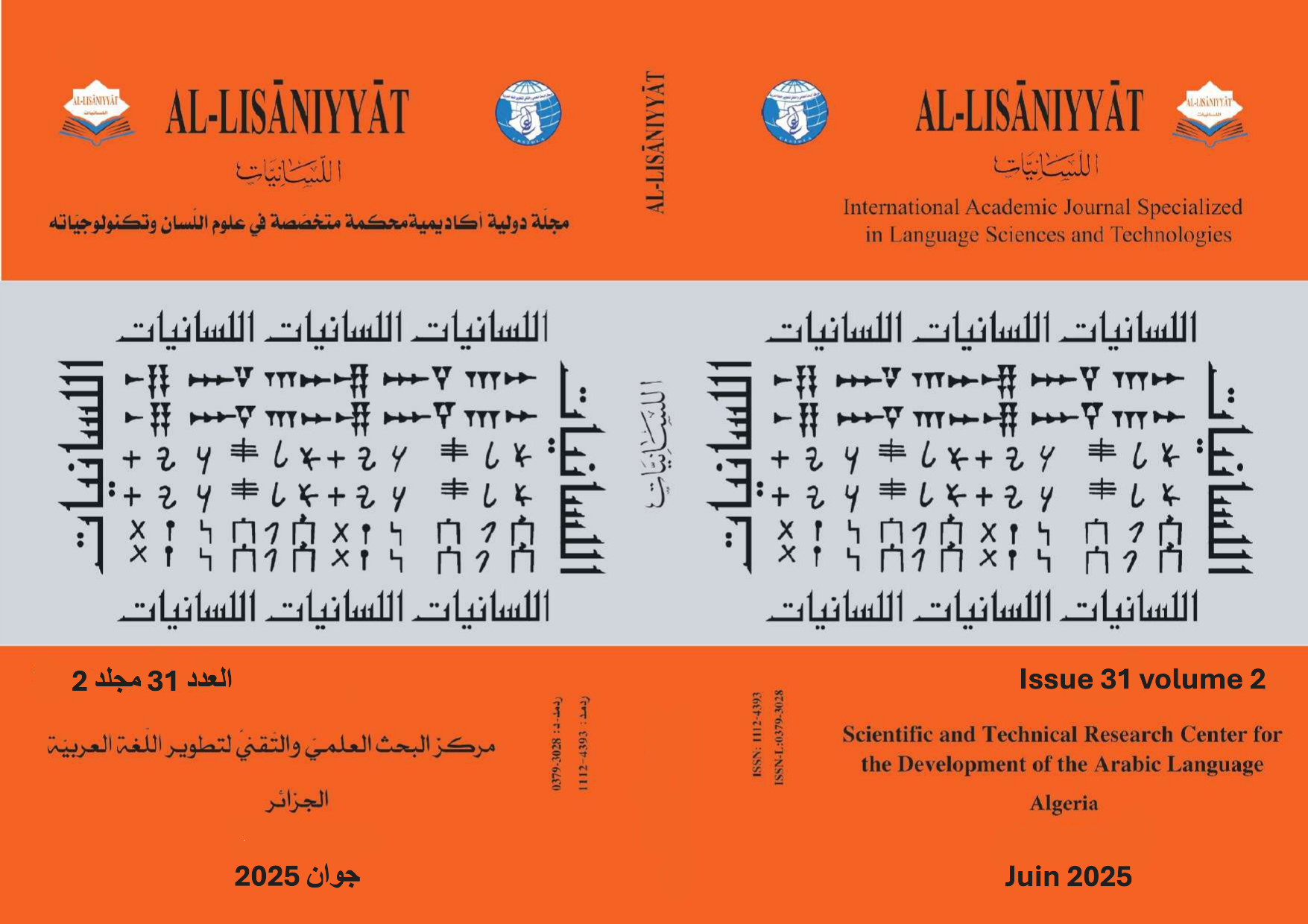The Principle of Coherence and its Impact on Text Readability
Main Article Content
Abstract
This study aims to emphasize that the readability of texts -their ease of comprehension- is fundamentally linked to the principle of coherence, which itself depends on the text’s dialectical relationship with the reader. Indeed, "there is no inherently coherent or inherently incoherent text independent of the reader."
The study of coherence revolves around two fundamental components of the text: the concepts it conveys and the relationships that connect them, along with the cohesive links that bind them together. As noted, "concepts and relationships together form the semantic foundation of the text."
This semantic foundation is not a pre-established entity; rather, it is constructed by the reader through the act of understanding, which involves the interaction between the reader’s prior knowledge and the information presented in the text. As stated, "the text is read by the reader... and the reader is equal to the text in terms of productive capacity and cognitive requirements."
This implies that a certain degree of compatibility and coherence must exist between the concepts and themes presented -whether explicitly or implicitly- and the reader’s prior knowledge.
Article Details

This work is licensed under a Creative Commons Attribution-NonCommercial 4.0 International License.
References
- بازي، محمد (2019). مبادئ أولية لمشروع قرائي متعدد الاستراتيجيات. المغرب: دار القلم العربي للنشر والتوزيع.
- البستاني، بشرى محمد (2011). في مفهوم النص ومعايير نصية القرآن الكريم. أبحاث كلية التربية الأساسية. 11 (1).
- بحيري، سعيد حسن (1997). علم لغة النص، المفاهيم والإجراءات. لبنان: مكتبة لبنان ناشرون.
- الزاكي، عبد القادر (2000). من النموذج النصي إلى النموذج التفاعلي. من كتاب جماعي: نظرية التلقي إشكالات وتطبيقات. الدار البيضاء، المغرب: منشورات كلية الآداب والعلوم الإنسانية.
- حسان، تمام. ( 1983 ). اللغة والنقد الأدبي. فصول. 1 (4).
- خطابي، محمد (2006). لسانيات النص، مدخل إلى انسجام الخطاب، الدار البيضاء، المغرب: المركز الثقافي العربي.
- فرج، حسام أحمد (2009). نظرية علم النص. القاهرة: مكتبة الآداب.
- الفقي، صبحي إبراهيم (2000). علم اللغة النصي بين النظرية والتطبيق. القاهرة: دار قباء للطباعة والنشر.
- فضل، صلاح (2004). بلاغة الخطاب وعلم النص. القاهرة : دار الكتاب المصري.
- سالم، محمد السيد إبراهيم (2021). انقرائية كتب اللغة العربية للطلاب الناطقين بغيرها بمركز اللغات جامعة الشارقة وعلاقتها بالتعبير اللغوي عندهم. التربية، 5 (191).
- صبيحي، محمد الأخضر (2008). مدخل إلى علم النص ومجالات تطبيقه. الجزائر: منشورات الاختلاف.
- طعيمة، رشدي أحمد (2004). الأسس العامة لتعليم اللغة العربية، تطويرها، تقويمها. القاهرة: دار الفكر العربي.
- مصلوح، سعد (1991). نحو أجرومية للنص الشعري. فصول، 10 (2).
- هانيه، فولفجانج، وفيهفجر، ديتر (1991). مدخل إلى علم اللغة النصي. فالح بن شبيب العجمي(مترجم). السعودية: مطابع جامعة سعود.
- Jean Adam, J. M. (1990). Eléments de linguistique textuelle: théorie et pratique de l'analyse textuelle. Editions Mardaga.
References
1. Abu Ghazala, Ilham, Hamad, and Ali Khalil (1999). Introduction to Text Science. Cairo: Egyptian General Book Organization.
2. Bazzi, Mohammed (2019). Initial Principles for a Multi-Strategy Reading Project. Morocco: Dar Al-Qalam Al-Arabi for Publishing and Distribution.
3. Al-Bustani, Bushra Mohammed (2011). On the Concept of Text and the Textual Criteria of the Quran. Research Journal of the College of Basic Education, 11 (1).
4. Bahiri, Said Hassan (1997). Text Linguistics: Concepts and Procedures. Lebanon: Lebanon Library Publishers.
5. Al-Zaki, Abdelkader (2000). From the Textual Model to the Interactive Model. In a collective book: Reception Theory: Issues and Applications. Casablanca, Morocco: Publications of the Faculty of Arts and Humanities.
6. Hassan, Tammam (1983). Language and Literary Criticism. Fusool, 1 (4).
7. Khatabi, Mohammed (2006). Text Linguistics: An Introduction to Discourse Coherence. Casablanca, Morocco: The Arab Cultural Center.
8. Farag, Hossam Ahmed (2009). The Theory of Text Science. Cairo: Library of Arts.
9. Al-Feki, Sobhi Ibrahim (2000). Text Linguistics: Between Theory and Practice. Cairo: Dar Quba for Printing and Publishing.
10. Fadl, Salah (2004). The Rhetoric of Discourse and Text Science. Cairo: Egyptian Book House.
11. Salem, Mohammed El-Sayed Ibrahim (2021). The Readability of Arabic Language Books for Non-Native Speakers at the Language Center, University of Sharjah, and Its Relationship to Their Linguistic Expression. Education, 5 (191).
12. Subhi, Mohammed Al-Akhdar (2008). Introduction to Text Science and Its Application Fields. Algeria: Publications of Difference.
13. Taima, Rushdi Ahmed (2004). General Foundations for Teaching the Arabic Language, Its Development, and Evaluation. Cairo: Dar Al-Fikr Al-Arabi.
14. Maslouh, Saad (1991). Towards a Grammar of Poetic Text. Fusool, 10 (2).
15. Hannyeh, Wolfgang, and Viehweger, Dieter (1991). Introduction to Text Linguistics. Translated by Faleh bin Shabib Al-Ajmi. Saudi Arabia: Saud University Press.
16. Jean Adam, J. M. (1990). Eléments de linguistique textuelle: théorie et pratique de l'analyse textuelle. Editions Mardaga.
